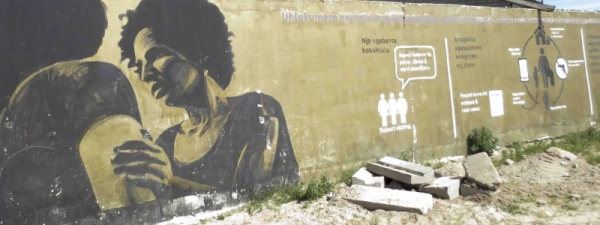We need more murals on rape - Makhaza resident

Following the creation in 2013 of a mural about abuse of women, Makhaza residents have suggested other murals should be built focusing on rape.
In June 2013 Heinrich Boll Foundation and the Tshwaranang Legal Advocacy Centre [created a mural]((http://groundup.org.za/article/violence-against-women-mural-unveiled-kha…) to create awareness around abuse women and children abuse.
When GroundUp visited the area last week, residents said when they went past they read the mural and thought about its message.
The long wall, mostly painted in purple has messages, drawings and text warning about abuse of women and children.
Mavis Joni (64), said that she liked to read the Xhosa message which is written on the mural and found it very helpful.
She said a woman she knew was being beaten by her husband inside their home, not far from the mural. The woman had told her husband that if he beat her again she would call people to beat him in front of the mural to teach him about abuse.
“I know people read the wall and whatever they read stays on their conscience. I think if there were more of this, focusing on rape, then Khayelitsha would be a better place”, said Joni.
Vuyiswa Benja said young people did not have time to read what was on the wall. There should be more activities centred on the mural so that young people would notice it and become interested in the topic, she said.
Benja also said that rape had become “epic” in the area and little had been done about. Any new murals should be focused on rape, she said.
Other people suggested that new murals should focus on alcohol and drug abuse because these were the main causes of domestic violence.
One of the nurses from a clinic near the mural said that the fact that the mural had not been vandalised showed that people appreciated it. But, she said, there should be more activities centred on the mural to make it relevant to people.
Claudia Lopes from the Heinrich Boll Foundation said that the intention in developing the mural was not only to raise awareness of the rights of victims of domestic violence and rape, but also to show that everyone, including the police, clinics, shelters for abused women, local government and community members had a role to play in the fight to stop violations of women’s rights.
Support independent journalism
Donate using Payfast

Don't miss out on the latest news
We respect your privacy, and promise we won't spam you.

This article is licensed under a Creative Commons Attribution-NoDerivatives 4.0 International License.
